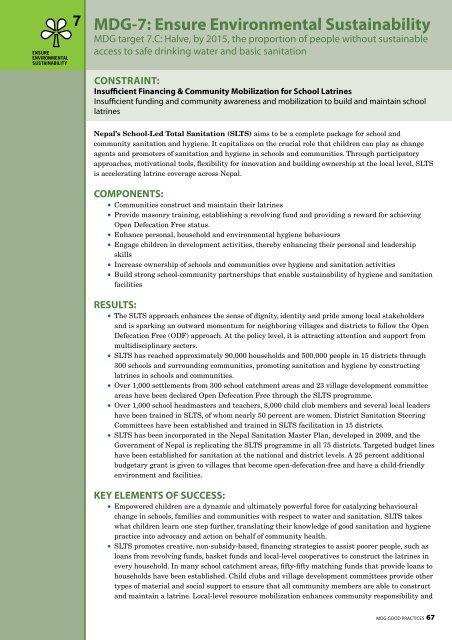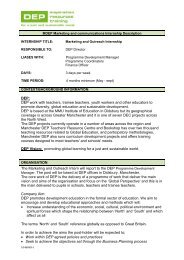Download - United Nations in Cambodia
Download - United Nations in Cambodia
Download - United Nations in Cambodia
- No tags were found...
You also want an ePaper? Increase the reach of your titles
YUMPU automatically turns print PDFs into web optimized ePapers that Google loves.
MDG-7: Ensure Environmental Susta<strong>in</strong>abilityMDG target 7.C: Halve, by 2015, the proportion of people without susta<strong>in</strong>ableaccess to safe dr<strong>in</strong>k<strong>in</strong>g water and basic sanitationConstra<strong>in</strong>t:Insufficient F<strong>in</strong>anc<strong>in</strong>g & Community Mobilization for School Latr<strong>in</strong>esInsufficient fund<strong>in</strong>g and community awareness and mobilization to build and ma<strong>in</strong>ta<strong>in</strong> schoollatr<strong>in</strong>esNepal’s School-Led Total Sanitation (SLTS) aims to be a complete package for school andcommunity sanitation and hygiene. It capitalizes on the crucial role that children can play as changeagents and promoters of sanitation and hygiene <strong>in</strong> schools and communities. Through participatoryapproaches, motivational tools, flexibility for <strong>in</strong>novation and build<strong>in</strong>g ownership at the local level, SLTSis accelerat<strong>in</strong>g latr<strong>in</strong>e coverage across Nepal.Components:• Communities construct and ma<strong>in</strong>ta<strong>in</strong> their latr<strong>in</strong>es• Provide masonry tra<strong>in</strong><strong>in</strong>g, establish<strong>in</strong>g a revolv<strong>in</strong>g fund and provid<strong>in</strong>g a reward for achiev<strong>in</strong>gOpen Defecation Free status.• Enhance personal, household and environmental hygiene behaviours• Engage children <strong>in</strong> development activities, thereby enhanc<strong>in</strong>g their personal and leadershipskills• Increase ownership of schools and communities over hygiene and sanitation activities• Build strong school-community partnerships that enable susta<strong>in</strong>ability of hygiene and sanitationfacilitiesResults:• The SLTS approach enhances the sense of dignity, identity and pride among local stakeholdersand is spark<strong>in</strong>g an outward momentum for neighbor<strong>in</strong>g villages and districts to follow the OpenDefecation Free (ODF) approach. At the policy level, it is attract<strong>in</strong>g attention and support frommultidiscipl<strong>in</strong>ary sectors.• SLTS has reached approximately 90,000 households and 500,000 people <strong>in</strong> 15 districts through300 schools and surround<strong>in</strong>g communities, promot<strong>in</strong>g sanitation and hygiene by construct<strong>in</strong>glatr<strong>in</strong>es <strong>in</strong> schools and communities.• Over 1,000 settlements from 300 school catchment areas and 23 village development committeeareas have been declared Open Defecation Free through the SLTS programme.• Over 1,000 school headmasters and teachers, 8,000 child club members and several local leadershave been tra<strong>in</strong>ed <strong>in</strong> SLTS, of whom nearly 50 percent are women. District Sanitation Steer<strong>in</strong>gCommittees have been established and tra<strong>in</strong>ed <strong>in</strong> SLTS facilitation <strong>in</strong> 15 districts.• SLTS has been <strong>in</strong>corporated <strong>in</strong> the Nepal Sanitation Master Plan, developed <strong>in</strong> 2009, and theGovernment of Nepal is replicat<strong>in</strong>g the SLTS programme <strong>in</strong> all 75 districts. Targeted budget l<strong>in</strong>eshave been established for sanitation at the national and district levels. A 25 percent additionalbudgetary grant is given to villages that become open-defecation-free and have a child-friendlyenvironment and facilities.Key Elements of Success:• Empowered children are a dynamic and ultimately powerful force for catalyz<strong>in</strong>g behaviouralchange <strong>in</strong> schools, families and communities with respect to water and sanitation. SLTS takeswhat children learn one step further, translat<strong>in</strong>g their knowledge of good sanitation and hygienepractice <strong>in</strong>to advocacy and action on behalf of community health.• SLTS promotes creative, non-subsidy-based, f<strong>in</strong>anc<strong>in</strong>g strategies to assist poorer people, such asloans from revolv<strong>in</strong>g funds, basket funds and local-level cooperatives to construct the latr<strong>in</strong>es <strong>in</strong>every household. In many school catchment areas, fifty-fifty match<strong>in</strong>g funds that provide loans tohouseholds have been established. Child clubs and village development committees provide othertypes of material and social support to ensure that all community members are able to constructand ma<strong>in</strong>ta<strong>in</strong> a latr<strong>in</strong>e. Local-level resource mobilization enhances community responsibility andMDG Good Practices 67








